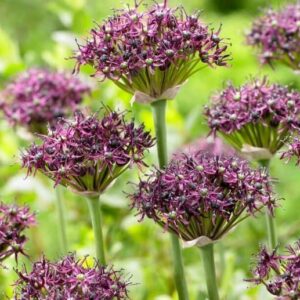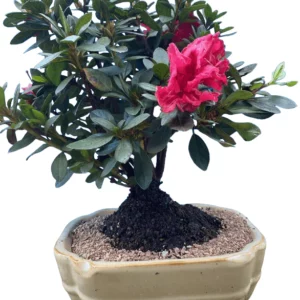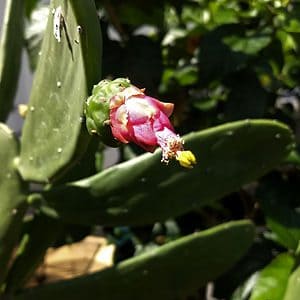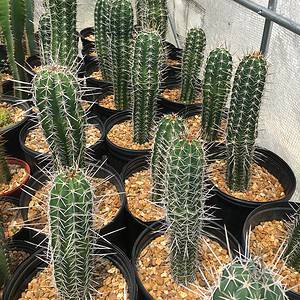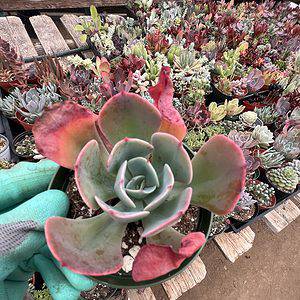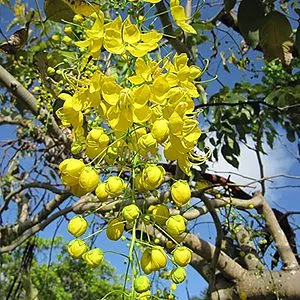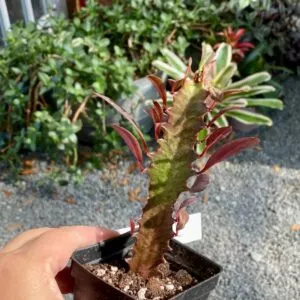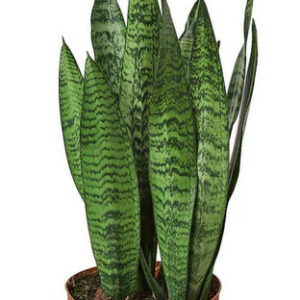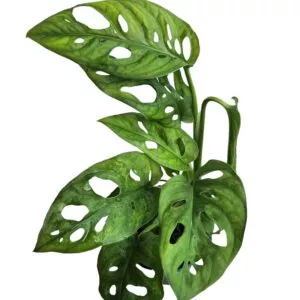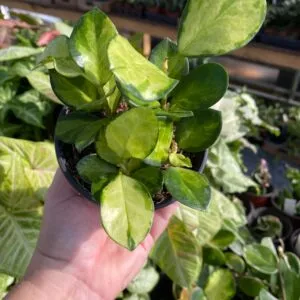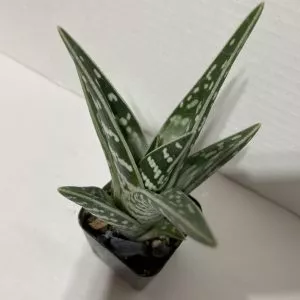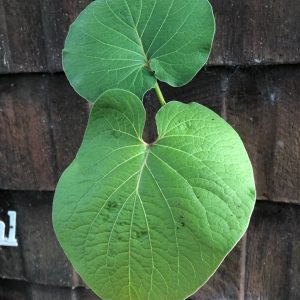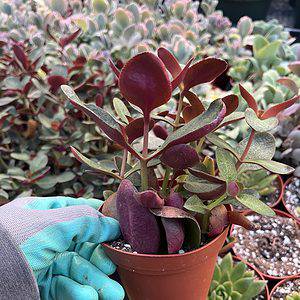No products in the cart.
Table of Contents
Nothing says it better for any occasion than a bunch of red carnations. Those frilly petals are so lovely, and yes, it makes for gorgeous floral arrangements with their spicy fragrance.
Yes, the pink carnation is the symbol for Mother’s Day, and in the olden days, people used it for treating fevers.
Still, during Elizabethian times people used Dianthus caryophyllus pink in ale and wine and even as a substitute for clove imagine.
So, looking at only some of these exciting facts, the Dianthus is a worthy investment as an indoor plant or in rock gardens.
Dianthus Flowers History
The Dianthus caryophyllus, known as clove pink, grenadine, and carnation, belongs to the Caryophyllaceae family.
The herbaceous plant is native to the Mediterranean and cultivated for its flowers with a clove smell used in the floral industry.
In the species, you find the carnations and the perpetual flowering carnation used for border greens or planted in containers in your home.
Yes, these flowers are also known as the flowers of gods, and the Greeks most likely used them as coronation flowers.
Still, the commercial carnation you see today has taken more than 200 years of breeding with a wide color range.
Another exciting thing is that new flowers you can quickly cultivate as they have cymose inflorescences to produce as a standard or sprays carnation.
For the standard carnation, they remove the lateral buds leaving the terminal flower. While with sprays, the terminal flower buds are removed, resulting in lateral bud development.
Dianthus Plant Care

The Dianthus plants you find bred in varieties with loosely tufted flowers and catch everyone’s attention and, yes, the nose as well.
You find these outdoor plants growing as a wild carnation and houseplants from cheddar pinks, garden pinks, red and more. So, get your hands dirty to start taking care of these cottage-style plants.
Species: Dianthus caryophyllus
Common Name: Carnation, clove pinks, border carnation
Plant Type: Herbaceous perennial
Native to: Mediterranean
Blooms: Gold/Yellow, Orange, Pink, Purple/Lavender, Red/Burgundy, Variegated, White
Maximum Size: One to four feet tall
Watering Requirements: Allow soil to dry between watering
Light Requirements: Full sun partial shade
Preferred Humidity: 70-75%
Preferred Temperature: Cool temperature
Soil or Potting Medium: Well-draining loamy soil
Fertilizer: Compost rich soil
Propagation Method: Seed and stem cuttings
Vulnerability: Fusarium wilt
Toxicity: Low-toxicity rate in the leaves
Now that you have seen the shortness and sweetness of caring for your Dianthus flowers, you can quickly grow them as a miniature potted or mini carnation houseplant. These new plant species range in height between six to eight inches.
In stock In stock In stock In stock
Free Shipping
$10.96
Sold By:
CZ Grain
10 Miniature Allium Bulbs for Planting Allium Atropurpureum
Rated 4.60 out of 5 based on 156 customer ratings00
Sold By:
CZ Grain
$19.99
Sold By:
BubbleBlooms
Pink Easter Lily Cactus Echinopsis oxygona Echinobivia Rainbow Bursts eyriesii Night-Blooming Hedge-Hogs. Live Succulent Plant in 4 inch Pot
Only 99 available and it’s in 1 people’s basket Rated 4.81 out of 5 based on 279 customer ratings03
Sold By:
BubbleBlooms
Free Shipping
$111.40
Sold By:
BONSAI WORLD LLC
Red flowering azalea bonsai tree in 8inch pot
Sold By:
BONSAI WORLD LLC
$19.95
Sold By:
Orchid Stuff Plus
$24.95A beautiful Royal Palm in a 4 inch pot.
Only 1 available and it’s in 1 people’s basket Rated 5.00 out of 5 based on 1 customer rating00
Sold By:
Orchid Stuff Plus
Best Well Drained Soil for Dianthus Plants
Okay, if you have an indoor carnation plant or plan to grow them outdoors, it needs slightly alkaline, well-draining soil.
For outdoor growing as young plants, make sure they have nutrient-rich soil. For example, you can grow your carnations in sandy soil with some peat moss or garden compost to make the ground lose.
You can add organic ingredients to help with drainage as your perennial Dianthus varieties are vulnerable to root rot even when grown as a houseplant. Adding mulch also helps suppress weeds.
When planted in garden beds, you can give them a boost using a granulated starting feed or a balanced all-purpose fertilizer like 12-12-12.
Ideal Lighting for Dianthus Carnation

One thing that is so great about the Dianthus plants is that all of them prefer full sun for at least six hours a day.
Whether you grow your Dianthus bloom as an annual or perennial outside or inside, they need the sun to bloom.
You can provide your new plants with bright light and partial shade in the afternoon for indoor placement. Yet, while your carnations can tolerate partial shade, you will find they might have fewer flowers.
Watering Your Plant Dianthus
Planting Dianthus flowers is a low-maintenance plant. New plants you need to water daily at first, and depending on the soil type and climate, you can adjust watering to every three days.
Suppose your gillyflower is growing in clay ground it will retain moisture longer and needs less watering. Also, provide water to your plant at the root area and not the entire plant.
Preferably, when you grow Dianthus, do not waterlog your plant and water when you feel the top two inches of the ground dry to prevent root rot.
In stock (can be backordered) In stock In stock
Free Shipping
$21.99
Sold By:
Gar-Zen Botanical Design
Opuntia Pear Spineless Cactus (2 Pads) Ships Free.
Rated 4.86 out of 5 based on 49 customer ratings00
Sold By:
Gar-Zen Botanical Design
$8.99
Sold By:
Cacti and Exotica
Cactiandexotica | Echeveria | Blue Sky
Rated 4.98 out of 5 based on 59 customer ratings00
Sold By:
Cacti and Exotica
Free Shipping
$38.96
Sold By:
CZ Grain
willow cuttings for planting
Rated 4.60 out of 5 based on 156 customer ratings00
Sold By:
CZ Grain
Temperature Provision

Your Dianthus species can tolerate a light frost but not severe freezing compared to some other plants. If temperatures dip below 40°F, you can cover your outdoor plants using a frost blanket. You will also find that these plants go dormant in warm temperatures above 85°F.
Fertilizer Condition
Dianthus plants do not need much feeding and are light feeders. You can provide them with a liquid fertilizer every six weeks during the growing season as potted plants.
Grown outdoors, you can work in a shovelful of organic compost once a year to keep them nourished. Alternatively, you can also use a slow-release feed in spring.
Propagating Perennial Dianthus
The good news is you can propagate your Dianthus spp from seeds, cuttings to division.
Grow Perennial Dianthus from Seeds
To cultivate the seeds, you need well-draining loamy soil done up to eight weeks before the last frost in the region. Then, for indoor planting, sprinkle the seed over the top and cover it with a layer of potting soil.
Next, cover the pot with a plastic bag and keep it in a warm place while keeping the ground moist. Once you notice two to three leaves, you can move your plants into their container but only do this when they are about five inches high.
You can also sow the seed directly outdoors at a depth of 1/8 inch after the frost passes. As with your indoor plants, you need to keep the soil moist, and once they reach five inches high, you can thin them out, placing them 12 inches apart.
In stock In stock In stock In stock
$8.95 – $11.99
Sold By:
CZ Grain
Golden Shower Tree Seeds for Planting – Cassia Fistula
Rated 4.60 out of 5 based on 156 customer ratings00
Sold By:
CZ Grain
$10.00
Sold By:
Smoot's Farm
African Milk Tree or Euphorbia Trigona Rubra Red Live Starter Suc
Rated 4.89 out of 5 based on 27 customer ratings02
Sold By:
Smoot's Farm
Free Shipping
$38.95 – $42.95
Sold By:
A&K Plants
Snake Plant Zeylanica – Air Purifying Houseplant with Wavy Grey Leaves | 6-inch pot
Rated 4.95 out of 5 based on 66 customer ratings00
Sold By:
A&K Plants
$10.00
Sold By:
PotHedz Plants
Monstera Adansonii
Rated 4.96 out of 5 based on 106 customer ratings00
Sold By:
PotHedz Plants
Perennial Dianthus From Cuttings

- Take a cutting from the mother plant that bloomed in June or July after flowering for an entire season. The cutting can be about three inches in length.
- Take a small pot with some vermiculite combined with moist potting soil.
- Dip the end of the cutting optional in a rooting hormone and plant in the ground with one node beneath the soil.
- Place the cutting in a sunny location and keep the ground moist.
- Once you spot new leaves growing that should take a month, you can transplant your carnation and care for it.
Division
Yes, you can even revive your old carnations by dividing the segments to create multiple flowers. To do this, you need to dig up the clump and pull them apart using your hand.
Yes, get all dirty and replant them like you would your annual or perennial greenery. You can do this every three years to keep them healthy.
Dianthus Annual or Perennial USDA Growth Zone
The hardiness of growing your Dianthus caryophyllus white to pink flower depends on the varieties you have. You can grow them in zones five to nine in the home year-round.
When grown in the garden and doubtful that they will survive, you can always take some cuttings or seeds to grow them annually.
In stock In stock In stock
$18.00
Sold By:
Smoot's Farm
Hoya Australis Lisa 4 Pot Live Starter Plant
Rated 4.89 out of 5 based on 27 customer ratings00
Sold By:
Smoot's Farm
$16.00
Sold By:
Beauties & Beasts
Cactus – Echinopsis chamaecereus (clumping)
Rated 4.83 out of 5 based on 24 customer ratings00
Sold By:
Beauties & Beasts
$9.99
Sold By:
Succulent Oasis
Small Succulent Plant Partridge Breast Aloe
Rated 4.84 out of 5 based on 352 customer ratings00
Sold By:
Succulent Oasis
Pruning Clove Gilly Flower
To help increase repeat blooming, keeping your carnation tidy and proper pruning helps. In addition, you can deadhead the spent flowers, especially on varieties that provide repeat blooms.
During the year, you can remove diseased or damaged leaves and stems. Then, when fall arrives, you can prune your plants back with about two inches of stem remaining above the ground outdoors.
By snipping off the dead flower, it helps prevent seed formation. It also helps encourage additional blooming.
Dianthus Varieties and Similar Plants
You are spoilt with choice if you want any Dianthus as the species offered is enormous. Yes, it is not your typical granny flower anymore.
Dianthus gratianopolitanus

The cheddar pinks is a charming evergreen perennial Dianthus that produces fragrant flowers rose to pink. You can add a splash of color with the cheddar pinks cut flowers in your home.
Dianthus deltoides

The maiden pink forms a spreading mat of green leaves, and from spring to summer, you get a display of red, white, or pink blooms and easy to grow.
Dianthus chinensis

China pink is an annually planted flower as they do not love hot, humid weather. The flowers look flat and heavily fringed with a dark central eye. It is best if you deadheaded the Chinese pinks to encourage flowering.
Dianthus barbatus
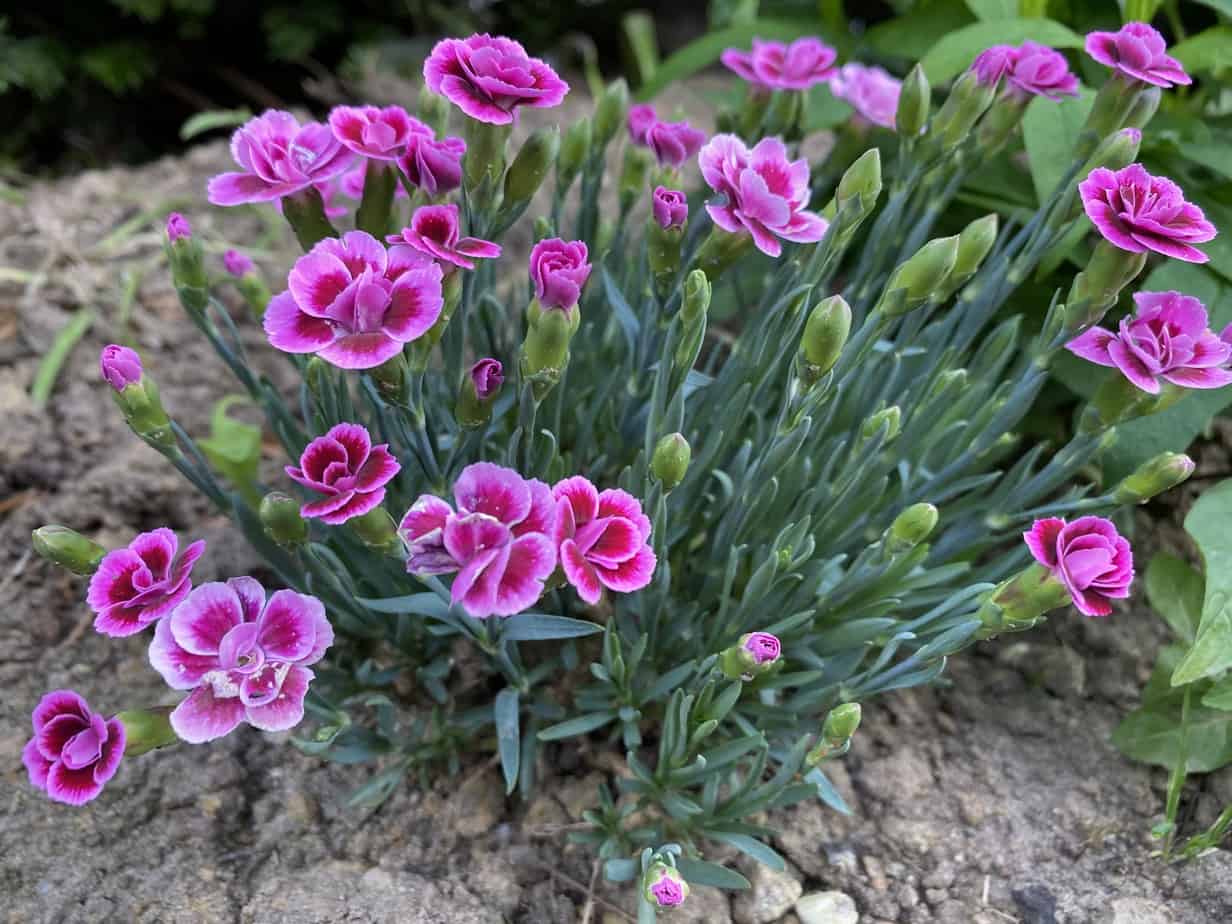
The sweet William is another flower best grown as an annual instead of a perennial. It thrives in full sun to partial shade and produces rounded yet dense flowers. The colors can be intense red, white, bicolor, to purple.
Dianthus Plant Diseases & Pests
The carnation’s history is rich, and it is an old cultivated flower. Still, it can also become vulnerable to pests and diseases.
Fusarium Wilt
The disease happens when the pathogen Fusarium enters your carnation, causing them to wilt their shoots slowly. Next, you notice leaf discoloration as the green turns pale yellow.
The stems split as the disease spreads, displaying brown streaking in the vascular tissue and root stem rot.
The disease results from exposition to high temperatures for a long time, and the best is to remove any diseased foliage.
Rust and Powdery Mildew
Your carnation can also get rust caused by poor ventilation. You can remove the infected leaves with a brownish mark and treat your greenery with a copper oxychloride.
Another concern is powdery mildew forming on the leaves from high humid conditions. Destroy your infected foliage and treat them with benomyl fungicide with enough ventilation.
Pests
Yes, your beautiful flowers can become the haven for aphids, spider mites, to flies. To prevent this from happening, you can control it with a spray of water and plant them with companion foliage like garlic. Or you can spray your carnations with garlic tea.
Frequently Asked Questions
As your carnation is a herbaceous perennial growing in zones six to nine, you should have a problem with this flower. Yet, when grown in colder climates, it is best to develop it annually.
Your carnation can tolerate pruning and responds well growing back lusher foliage. You can pinch off spent flowers that wilt and prune them back in fall down to two inches above the soil.
Your pink Dianthus is not long-lived foliage and gets woody at the base and needs replacing after six years. The best is to take seeds or cuttings each year to keep your plants going.
Luckily, the carnation is not a rare plant, and you find them at your local garden center. But you can also find it online here at Plantly. So, there is no need to leave your home as the carnation you receive at your door.
Whether you want to buy, sell, or simply reach out to other plant enthusiasts, Plantly is the right place to be!
In stock In stock (can be backordered) In stock In stock
$18.95
Sold By:
SunSoul Plants
$24.95LIVE Piper Auritum plant in a container, potted with soil in 4″ pot
Rated 4.87 out of 5 based on 98 customer ratings01
Sold By:
SunSoul Plants
Free Shipping
$15.99
Sold By:
Gar-Zen Botanical Design
Cuphea hyssopifolia Mexican Heather Elfin Herb Pollinator.
Rated 4.86 out of 5 based on 49 customer ratings00
Sold By:
Gar-Zen Botanical Design
$18.95
Sold By:
Orchid Stuff Plus
Golden Pathos (Epipremnum aureum) in a 4 inch pot!
Rated 5.00 out of 5 based on 1 customer rating00
Sold By:
Orchid Stuff Plus
$10.99
Sold By:
Cacti and Exotica
Crassula multicava
Rated 4.98 out of 5 based on 59 customer ratings00
Sold By:
Cacti and Exotica
